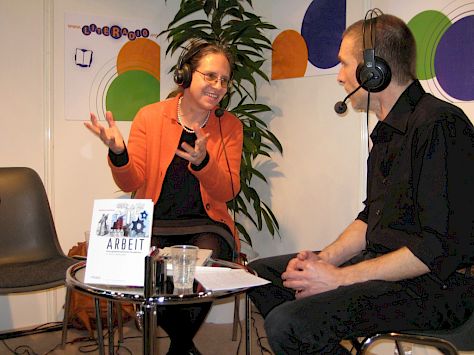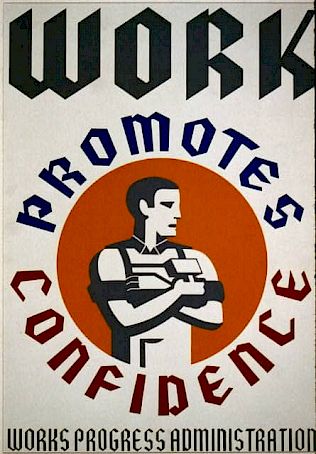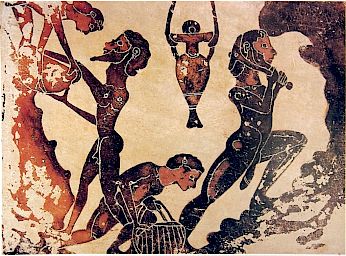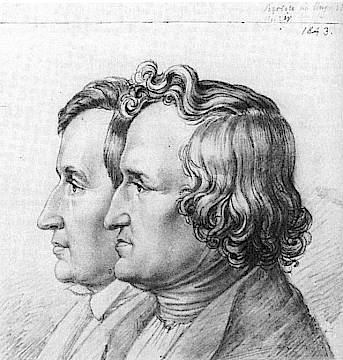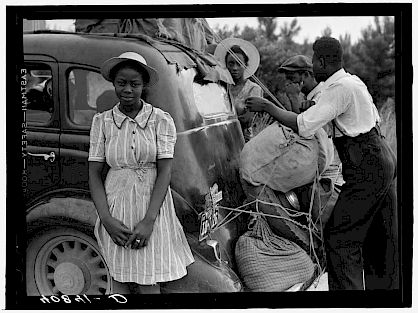Getting to (Global) Work with Andrea Komlosy: Discussing "Work: A Global History"
Work remains ever-present with us, yet somehow elusive. We spend more time doing it than anything else, other than sleeping, and yet defining what, exactly, the term means can be a challenge. Part of the reason may be the decline of solid salaried work, where one punched in and out of the factory, and knew that hours logged meant hours logged. For a time, even white-collar workers had the certainty of knowing that the weekend was just that – physical and infrastructural distance from fax machines, cell phones, and the papers, mountains of paper at the office. Today, however, many people not only allow office e-mail to intrude into the weekend; more than that, they embrace working from home.
Others are less lucky. Among historians, those who wash out in the brutal competition for the promise of tenured lifetime employment sometimes submit to the even crueler reality of the adjunct route. The root of the term itself demonstrates their precariousness: in linguistics, an adjunct is an optional, a "structurally dispensable" part of an utterance. All the same, as more and more work seems to become "casualized" (another telling term), organizers demand rights and privileges that were traditionally bundled with "full-time" or "traditional" employment. All the while, back at home, partners may grumble that there is precious little talk of unionizing or granting medical insurance to those of us stuck doing dishes, vacuuming, or putting a hot meal on the table.
The vocabulary that we use to talk about work remains, in short, of massive political importance, but all too often, we don't scrutinize it very closely. Not, at least until Andrea Komlosy's 2014 book Arbeit: Eine globalhistorische Perspektive (Work: A Global History Perspective), published by Promedia Verlag. We recently had the chance to speak with Komlosy about her road to writing about social history and the history of work, as well as what it means to apply a global history perspective to a theme that necessarily stretches across hundreds of years. Let's get to work, then, and dive into a discussion about Work.
•
We start the interview by asking Komlosy a bit about her background. She is, she notes proudly, a gebürtige Wienerin – someone born and raised in Vienna. Her ancestors were from Hungary and the territories that today comprise the Czech Republic (Bohemia and Moravia), but her parents were both proud members of postwar Vienna'a enlightened Bildungsbürgertum – a professional bourgeois setting that placed a strong emphasis on cultural achievement (lots of sports, piano lessons, and concerts) and left women much freedom to plot their own professional future. After receiving her secondary education in Hietzing, a western suburb of Vienna, she arrived at the University of Vienna in 1976, the beginning of a long engagement with that institution. She initially flirted with studies in French, Russian and Lehramt (the route to becoming a secondary school teacher), but Komlosy remained interested in unifying a career in history –social and economic history – with a budding interest in inequality as a political subject. She continued studying Political Science at the Institute of Advanced Studies in Vienna.
Inequality – the "I" word is on the tip of everyone's tongues today, but thirty years ago it had barely penetrated the discourse in places like Austria. And how, as a politically engaged scholar, to write a history of inequality? Komlosy spent much of the coming years trying to figure out answers to these questions. Following her completion of a first PhD in 1984, she ran as a candidate for the Austrian Greens (Alternatives) in 1986 elections and later worked in museums and as a teacher of history and political science in several Austrian universities. By the mid-1990s, she started a Habilitation (a second, more intensive doctorate often required to become a professor in German-speaking academia) that aimed to pursue a history of inequality in a perhaps unlikely setting, namely the Habsburg Monarchy.
Why do this? Since the 1970s, movements striving for a New International Economic Order, and ideas like dependency theory, it may be common to have as our default frame of reference for debates about inequality the global, or the national: either too many people in the Global South are starving or bankers' private airplanes cost too much. And yet the dominant political form prior to the twentieth century, namely empire, was also plagued by inequality. Nor just in the most obvious sense that India or Guinea was poorer than London or Paris, respectively. Continental empires, perhaps even harder to remember since they died earlier, also had massive problems of internal inequality that themselves triggered familiar debates about labor migration and the differential cost of labor between two locations.
Looking at imperial history in this way cast a new, refreshing light on seemingly tired themes. For someone attuned to post-1970s debates about inequality and capitalism, moreover, Austria-Hungary could be remained as no a candyfloss world of balls, feathered hats, and Arch-Dukes, but indeed a laboratory of capitalist modernity wherein investors, bureaucrats, and, not least, laborers, thought about how to manage industrial capitalism in a polity that included some of Europe's richest regions and, fatefully, Sarajevo. Not only that, but during the 19th century, Austria-Hungary went from a polity that absorbed economic migrants to one of the largest sources of emigrating laborers, often headed to the German Empire or the New World. In her Habilitation, later published as Grenze und Ungleiche Regionale Entwicklung. Binnenmarkt und Migration in der Habsburgermonarchie (The Border and Unequal Regional Development. The Internal Market and Migration in the Habsburg Monarchy), Komlosy bit off a (literally) familiar part of this story, examining the Habsburg Monarchy's Bohemian, Moravian, and Austrian borderscape as a space of economic and administrative experimentation.
Still, throughout the writing process, Komlosy kept bumping into the limits of the history of writing about the history of work. Indeed, understanding why a work like Arbeit: Eine globalgeschichtliche Perspektive matters requires a little bit of delving into the tradition of labor history. Her starting point for pursuing the project was simple: "I wanted to investigate how new concepts and forms of work were created by the Industrial Revolution. I wanted to understand how we got to a point where there was such a sharp distinction between Lohnarbeit (salaried work) and everything else." That sounds simple enough, but received traditions of Marxism, Komlosy notes, lent many with sympathies for writing "labor history" a certain blindness towards non-salaried work as a lens of analysis. The more that one tended to glorify the (rapidly disappearing) unionized steel worker as the prototype of modern work whose history needed to be told, in short, the less attention one paid to the Turkish or North African guest worker – or indeed the housewife.
That's alarming, Komlosy notes, not just for people with sympathies for a progressive or Leftist politics, but also because the overweening focus on Lohnarbeit eroded an awareness of a conceptual history of concepts like Werk (of which more in a moment) or Gebärarbeit (an older German term for the "work" of giving birth). Komlosy is quick to add that her politics don't necessarily lead her to support the remuneration of housework, but her broader point is simple: assuming the primacy of the commodity form of labor can lead us into intellectual and political dead ends. By the 1980s, she adds, it was impossible for anyone reading the newspaper not to be aware of global inequalities and labor flows that manifestly had little to do with the struggles of trade unionists or coal miners. Sympathize as she might with those who wanted to write a "history from below" of the Austrian, or any other country's working class, it was important not to mistake valorization for provincialism.
Of course, as Komlosy is quick to add, it's important not to depict labor history as a bunch of trade union apologists plying their craft further and further down a dead end. The traditional instinct to write labor history as a dynamic of exploitation and resistance was perhaps particularly strong in countries like Austria, which had strong memories of "Red Vienna" of 1918-1934, when a Social Democratic government turned the former Habsburg capital into an eclectic laboratory for worker-friendly policies and avant-garde cultural politics.
But ironically, it was the legacy of the downfall of such left-wing governments that unintentionally created new possibilities for writing labor history for people of Komlosy's generation. During the 1930s, she explains, as fascist governments took power across much of Central Europe, historians like Nicholas Posthumus, a Dutch economic historian, grew alarmed that the material legacy of Marx, Engels, and socialist parties would be destroyed. Buoyed by financial support from insurance companies with close ties to Dutch Social Democrats, Posthumus and pioneering librarian Annie Adama van Scheltema-Kleefstra moved holdings like Nikolai Bakunin's manuscripts from Vienna to Amsterdam right before the Nazis marched in. These and other materials from pre-collapse Republican Spain became part of the core holdings of the International Institute of Social History, in Amsterdam. While the Institute suffered greatly during World War II, state support turned it into a favored repository for persecuted Leftists across the world, and today it constitutes one of the leading centers for the study of social history and the Left in the world.
The point, stresses Komlosy, is that the resurgence of centers like IISG and the decline of the European worker's movement, at least as traditionally understood, by the 1970s and 1980s, helped open up new potential research horizons. The "persecuted archives" held in Amsterdam made it exceptionally clear that "labor history" did not end with iron mills and coal mines, but that it also included fruit pickers, peasants, and students, too. The "way to a more differentiated form of worker's history beyond just the history of exploitation of wage labour" was slowly cleared, explained Komlosy. Cleared, then, but maybe not sufficiently conceptually foregrounded. Such was the intellectual background facing Komlosy when she sat down, some five or six years ago, to put pen to paper and begin work on a global history of work.
•
We dive into the meat of the book, the first half of which consists of investigations into the concept of work from different angles. Komlosy makes clear her indebtedness to the work of German social historian Werner Conze, who sketched out a conceptual schema to the concept of work in the volume, co-edited by him and historians Otto Brunner and Reinhard Koselleck, Geschichtliche Grundbegriffe (Historical Concepts). Conze's was the first exhaustive treatment of the concept since Max Weber's, but, notes Komlosy, his treatment was also a classic example of Eurocentrism, as well as one that left women's contributions to the conceptual field surrounding "work" understudied. That matters, too, because such shifting conceptual boundaries performed crucial work in bracketing out space around a "legitimate" concept of work. It's crucial not to posit ideal types of work based on the European experience. After all, what looks like a general trend – say, de-industrialization – from the Rust Belt, Sheffield, or Eastern Europe can actually be highly deceiving, since one region's de-industrialization often went hand-in-hand with industrialization in the Global South. Perhaps more importantly – here are echoes of Komlosy's earlier work – truly gigantic profits have been made by exploiting regional or global inequalities, and by connecting work in poor areas to consumer markets in rich areas.
Having sketched this out, Komlosy begins to explore multiple discursive approaches to work – as something to be overcome (Überwindung), something to be idealized (Idealisierung), and something potentially transformative (Gestaltung). Drawing on examples from different contexts, she stresses that history has never been marked by a linear move from the dominance of one discourse to the other; but rather that, even though one discourse may have been dominant in a society at a particular time, they compete with one another. The idea of work as something to be avoided has, of course, a rich history. The Ancient concept of a vita contemplativa made sense only in contrast with a vita activa marked by toil and labor, and Ancient Greek civilization had a strong sense that free citizens had to avoid work – hence the slavery – to participate fully in public, democratic life. This concept has a long life, of course. 19th century figures like Paul Lafargue argued, contrary to Marx's idea of a "right to work," for a "right to laziness." And in the 20th century, European Leftist groups with both sympathy for the Third World and a suspicion of multi-national corporations have taken this concept farther, fusing anti-consumerist ideology with a criticism of said corporations' overseas workplace conditions.
Of course, this discourse has and has had challengers. Ora et labora: pray and work, went the slogan of medieval Christian orders that believed in the importance of uniting the vita contemplativa with the vita activa. German sociologist Max Weber later connected the Protestant (specifically Calvinist) ethic with the development of capitalism, and no less than Karl Marx stresses the emancipatory aspects of work for the progress of universal history. However gruesome Man's servitude to the machine might have been, Marx recognized that "the entire history of the world [Weltgeschichte] is nothing other than the production of man through human work." And however much Marx's writings stressed the jump from the kingdom of necessity to the kingdom of freedom (the part about hunting, fishing, herding, and critiquing, without wanting to be a hunter, fisher, herder, or critic), part of the point was that capital itself, through the contradictions it developed, has a "civilizing side" to it, beyond the exploitation. This idea of work as emancipatory found darker expressions around the world in the twentieth century, too – think of Soviet or Chinese "corrective labor camps" or, perhaps more darkly still, the Nazi slogan of "Arbeit macht frei" that hung over the gates of Auschwitz.
Throughout, however, both of these concepts have intersected with a third concept of work, namely that of work as transformational. Both factory owners and socialists at the time of the Industrial Revolution dreamed of the workshop floor not just as a place of brutality, but also as one where workers could be educated into something less than bourgeois mores, but also better than mere robotic, sweaty slaves. Indeed, for later social democratic parties, the idea of a "right to work" went hand in hand with the expectation that work had to be made into something transformative and educational.
Yet as Komlosy points out, the balancing act between work as something transformational, as formational for identity, and of simple demands for daily bread or a paycheck, has ambiguous consequences when applied to other contexts. When early members of the women's movement demanded an equal right to education, equal access to the job market, and equal pay, "they almost necessarily took upon themselves a definition of work that was developed from a masculine perspective," writes Komlosy. Such demands for women's work have historically clashed head-on with traditionalist views of women as wives and mothers – itself a vision that implicitly endorses the idea of transformational if hardly ever paid work. Debates to this day surrounding equal pay, paid maternal leave, and paid paternal leave, or, most radically, paid housework all revolve around this conceptual field. The status quo in the richest of countries, however – "the creation of paid daycare positions that are based upon the premise of the privatization of household services" – barely lives up to these earlier feminist hopes.
Of course, running through all of this discursive history was a changing meaning to the word "work" itself – both in German, as Komlosy shows, as well as in every other European and non-European language. The point, however, in Komlosy's Arbeit is less to provide an exhaustive overview than to show what she sees as a general trend, namely the conquest of a concept usually associated with laborious work over one that stressed an idea of creative work. Historically, explains Komlosy, critiques of "work" centered around a division between (to take the Greek and Latin) pónos and labor on the one hand, and ergon and opus on the other. The former pair designated work usually performed by slaves or work performed under duress. The French travail and the Spanish trabajo, for example, stem from the Latin term Tripalium, an instrument of torture to punish unindustrious slaves. Érgon and opus, in contrast, referred to "work" that required skill (techné) or creativity (poises). More than that, Antiquity prized a state of leisure (otium) as necessary for the vita contemplativa and the creative, technical feats it could produce. For a time, German retained something of this divide – between the ubiquitous Arbeit (the general word for work) and Werk (usually associated with more creative deeds). The same is true for Russian and many Slavic languages apropos the distinction between rabota and trud. Finally – to return to English – one might mention the distinction between "work" and "labor" in English; the former is more common, but hints of boundary-crossings remain when we talk of an author's "collected works" or of a woman "going into labor."
How did we lose this distinction? As Komlosy shows through a fascinating in-depth discussion of the Brothers Grimm's dictionary, a project they began in the 1830s, even well into the process of industrialization in Europe "a restriction [of the concept] to wage labor cannot be recognized." True, the Grimms recognized little distinction between Werk and Arbeit, but their definition of what constituted Arbeit was surprisingly capacious. As the two etymologists saw it, the original meaning of the word had to do with tillage of the land carried out by a farm laborer, but "head work" and "spiritual work" also came under its heading. Interestingly, however, the Grimms were writing at a time when child birth – also known as labour, of course – was receding as a form of accepted "work." Earlier German texts dating back to the 16th century spoke of Gebärarbeit (birth work) as a common form of work; the Grimms, meanwhile, assigned "the fine work of women with the needle, sewing, embroidery, and cleaning" under the heading of "handicraft."
The real turn, however, was to come as the Grimms were composing the book, as the spread of wage labor led to a retreat of the concept of Werk. For the Grimms, the terms employer (Arbeitgeber) and employee (Arbeitnehmer) referred exclusively to the process of "ordering" and paying for a work force (Arbeitskraft), the value of which rose and fell according to the demands of the market. Werk, in contrast, was still bundled up with more creative work, or with expressions like "the work of God," "the work of the devil," or even Werk as a term to refer to sexual intercourse. Gradually, however, the negative associations surrounding Arbeit or labour as something forced, indeed enslaving, decreased to the point that a distinction between Werk and Arbeit made less and less sense. (Of course, this decrease in conceptual tension occurred at precisely the same time that idealizational discourses of work came into especial vogue, whether in their Marxist or non-Marxist form.)
Of course, Komlosy is quick to stress that the genealogy of the concept of work varies greatly from linguistic world to linguistic world. In socialist China, as she shows in a brief review, the story is one of the rise and fall of the gongren, the non-alienated socialist worker toiling in a state-owned factory. Today, as workforces are rationalized, the reality is more typically one of a "floating population" (lauding renkou) moving from job to job, and a growing class of domestic servants (fuwuyan) who sometimes describe themselves as yongren, referring to an Imperial-era term for court servants. The parallels between Arbeit and Werk in the German context, or between work and labor in the Anglophone context, are far from obvious, and it speaks to the need for more work in global intellectual history and the history of "words in motion," with respect to work as much as with other concepts.
Finally, as Komlosy explains, any discussion of the concept of work has to, beyond looking at the historical use of the term, explain itself with reference to different categories of analysis – subsistence work, communal work, work for tribute, work for sale on the market, independent work, dependent work, free work, unfree work, honorable or unhonorable work, voluntary or forced work, paid or unpaid work, contractual or formal work versus informal work, socially safeguarded versus unprotected work, unionized versus non-unionized work, and a host of grey zones – "getting by," underground work, or shadow work. Of course, in a 200-page work, Komlosy's aim is less to provide a definitive global history of all of these forms of work – much less how they intersect with issues of class, nationality, or gender – and more to problematize for future historians the conceptual landscape they have to deal with to write "a," to say nothing of "the" history of work in a particular time or place, or for a particular group of people.
Arbeit shifts gears in the back half of the book, as Komlosy follows the career of the concept of work across several centuries, taking six years – 1250, 1500, 1700, 1800, 1900, and 2010 – as emblematic of broader shifts. Like much of the book itself, their main utility is less as "the" definitive account of work in a particular time or place, and more of a general schema that future authors of dissertations, monographs, and more specialized works in the revitalized field of the history of work can use to guide them. Still, to get a sense of the approach, it might be useful to follow Komlosy's diagnosis of work circa 2010.
"The characteristic worker of the new, post-industrial and post-Fordist world of work is the precarious, flexible workforce. This workforce consists of residents as well as so-called 'people with a migration background,' who have ended up long-term at the point of migration. The constant adaptations of production factors to changing assignments, cost structures, and competition has , from the perspective of the individual firm, made flexibility more important than long-term experience and loyalty to fellow workers. Older long-term workers are replaced by younger short-term workers, appointments through work contracts and petty employees. Through the employment of subcontractors, different classes of workers for the same activities can be created: subcontractors are assigned to another class of activity, are subject to different wage contracts, and have to leave the workplace first, in order to be deployed by their agency somewhere else again as a flexible, relocatable mass with an uncertain length of employment."
Nor are these the only features of the global world of work today. Today is marked not only by this mood of uncertainty and flexibility, but also by the changing attitudes of states towards work itself. Whereas earlier welfare schemes saw welfare payments as a social transfer guaranteed by a social contract, new schemes, like Germany's Hartz IV system place strict pressure and surveillance on recipients of social aid in order to "integrate" them back into the labor market as quickly as possible. Even as a hefty political debate has raged over the (general) minimum wage, the Hartz IV system created a category of so-called "work opportunities with additional expenses compensation" – also called "One-Euro-Jobs." Under the program, long-term job-seekers could be moved into industries like elder care, food service, supermarkets, and so on through state subsidies, while receiving minimal payment themselves. The policy remains strongly debated, but critics like Komlosy point out that one effect of these state labor market policies has been to sink the average wage in Germany itself, hence allowing enterprises a lower labor cost and more competitive exports in the broader European market. Without overreaching too much, one can see that there is always a connection between the politics of the labor market (especially in perpetual exporting countries) and the politics of regional economic integration. Again, "labor history" conceived broadly has wide bounds.
The flip side of this process, of course, is the movement of cheap labor from export-purchasing countries to exporting metropoles – Germany in the case of Europe, although there may be parallels with rich Gulf countries as purchasers of construction and medical labor, too. Ironically, many young (and disproportionately female) workers may end up leaving their own families in places like Slovakia, Greece, Romania, or Bulgaria to come to Germany, the Netherlands, or other wealthy Northern European countries to work in senior care centers. The commodification of elder care in several of these richer countries, which itself creates "trans-local" households in Germany (grandpa in the elder home, the rest of the family living independently) drives the movement towards a different kind of trans-national household for denizens of poorer EU countries.
For Komlosy, the ongoing Eurozone crisis is itself a reflection of the contradictions involved in the project of creating a European Großraumwirtschaft, whereby the consumption (and to a lesser extent labor) of poorer Southern European countries was expected to maintain the global competitiveness of Northern European exports. Whether such a system could work if rich countries were prepared, in effect, to pay poor countries for the right to export to them, remains unclear. For Komlosy, however, the replacement of "the democratic system through financial commissars" and an insistence on "responsibility" and "austerity" obscure the processes of peripheralization and exploitation of internal inequality (here meant analytically, not pejoratively) that need to be faced to master the European crisis. Once again, what seems to be a discussion about work soon takes on broader dimensions.
•
We turn the discussion from Arbeit: Eine globalhistorische Perspektive to Komlosy's current activities. The Schumpeter Foundation, she notes runs a program to bring an Austrian scholar to Harvard University every year, and after several years of teaching and working on the book, she's glad to have the chance to network with American colleagues and explore what's percolating in the global history scene around Harvard's Weatherhead Initiative on Global History (WIGH). (Former TPF interviewee Julio Decker was a fellow at said program in the 2013-14 academic year.) Thus far, she's used the year to take part in the structure of a weekly Global History seminar, but also to do a bit of academic travel, lecturing at SUNY-Binghampton, historically a center for the study of global systems theory. But, more than anything, Komlosy jokes, "I'm happy to be freed from the 'work' of teaching!"
Looking to the future, however, she's also interested in pursuing a history of industrialization as a global problem. Ever since the original industrial revolution, national élites in countries like Mexico, Brazil, South Korea, Turkey and Iran have seen industrialization as a discrete project that the state could promote. "What," she wonders, "did these nationalizing industrialization projects learn from one another?" Thanks to the work of WIGH organizers like Sven Beckert, scholars are beginning to recognize the extent to which there existed a global dialogue, a give-and-take, between all kinds of regimes about the agrarian problem; what interests Komlosy is the extent to which one could pursue a similar research agenda with industrialization, rather than agrarianism, as the core problem. Komlosy is just at the beginning of her reading and inquiries for such a project, but she hopes to develop the idea further during the remainder of her Schumpeter-funded year at Harvard and in Vienna.
This brings us to the question of what different national traditions of global history might have to learn from one another. Sheltered within the confines of WIGH, Komlosy admits that she's not as familiar with American graduate education as she'd like to be. But, she adds, "I'm a promoter of the mass, the open university with no tuition fees." She's a product of the Massenuniversität herself, and even if teaching lecture classes to 600 uninterested undergraduates from all sorts of backgrounds may not always be as scintillating as 4-person seminars with ultra-professionalized graduate students, her social democratic instincts win out in the end.
But her time at Harvard has also underscored to her the difficulty of institutionalizing global history as a field. Harvard is full of people doing projects that could be classified under the rubric of global history, but the persistence of national fields as an organizing principle is strong. That might mean that the people working on Indian industrialization under Nehru don't think to compare themselves to people interested in the postwar Japanese, Turkish, or Brazilian experience. In the meantime, the best that some scholars can hope for is to land at institutions, or in cities, where there's a rich area studies tradition. Fortunately, Vienna fits the bill in this regard, as it boasts centers like the Institute for East Asian Studies or the Institut fuer Iranistik (Iranian Studies Institute at the Academy of Sciences) that provide a strong basis for scholars to connect the regional with the global in their work.
Reaching the end of our discussion, we ask Komlosy what she's been recently reading and what she would recommend to students or scholars interested in the field. Sven Beckert's Empire of Cotton (recently reviewed by TPF) is her answer to the first question – "a book," she says,"that raises the idea that cotton can provide a lens for the history of capitalism." But she also notes that readers would be well-served by looking back to some classics in the field, namely Immanuel Wallerstein's The Modern World System. Wallerstein's massive work began in the mid-1970s, but Komlosy is among the many who eagerly awaits the release of Volumes 5 and 6, reportedly on the way. Beyond these works, she mentions the late Giovanni Arrighi as an intellectual hero of hers. Komlosy cites his last book, Adam Smith in Beijing: Lineages of the Twenty-First Century, as worth reading for any and all scholars of global history.
Lohnarbeit it may not have been, but Komlosy's conversation with the Global History Forum has shed light on an important theme in the reinvention of global history. Imbricated as discussions of work – paid and unpaid – are in our everyday academic discussions about adjunct work, tenure-track jobs, or, for German-speakers, Teilzeit positions, it's more important than ever to investigate the history of a core concept like work. Here's hoping, then, that Arbeit: Eine globalhistorische Perspektive finds translation into English and other languages as soon as possible. We're grateful to Professor Komlosy for taking the time to speak with us for this installment of the Global History Forum.

